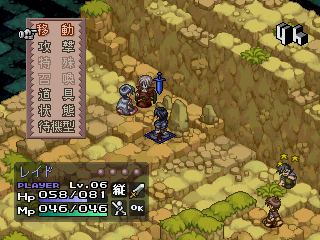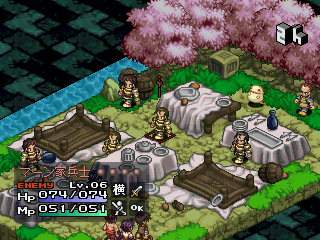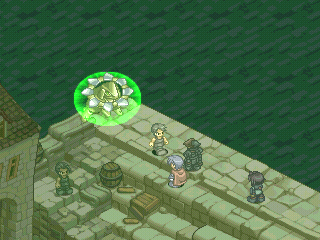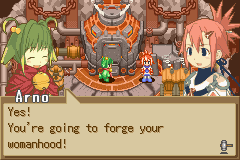
|
<<< Prior Page |
|
Page 1: |
Page 2: |
Page 3: |
Page 4: |
Page 5: |
Summon Night began as a series of strategy-RPGs created by a small Japanese company called Flight-Plan and published by Banpresto. Although they've received very limited exposure outside of Japan (only a few of the spinoffs have been localized), their attractive character artwork and heavy focus on plotline have won them a number of fans amongst the anime and manga-loving crowd.
For all intents and purposes, Summon Night is like a Tactics Ogre-lite. The basic interface and gameplay mechanics are practically lifted wholesale, and the PSOne games look almost identical, right down to the 2D graphics. Unit positioning and height plays a big role in proper strategy, as does counter-attacking. The major difference is that Summon Night is much more colorful and a bit more light-hearted - they're not nearly as comedy-based as any of the Nippon Ichi Strategy RPGs, but they're mostly devoid of the political drama portrayed in any of the Ogre Battle titles. They're also quite a bit easier, since they seem to be aiming for a target audience - the difficulty and complexity is roughly on the same level as Sega's forgotten (and nowdays, mostly befouled) Shining Force series. Slain characters are removed immediately from the battlefield, although they are not killed permanently. Although some battles can prove to be a bit difficult, it's nothing that a few battles spent grinding won't solve. Beyond equipping items and altering various elemental abilities, there's no real way to customize your characters, although there's usually a large roster of selectable units that build up over the course of the game.
There are a few unique elements that set Summon Night apart. Most of your units can be set to "defend" or "counterattack" mode. Whenever they are attacked, they'll either shield themselves to reduce damage, or take the full brunt of the assault in order to take a swipe back at their foe. Therefore, you need to balance the tight line between offense and defense to really do well. Additionally, unlike most SRPGs, characters do not gain experience in battles based off their actions. At the end of each stage, you're given a set amount of party experience, which you can distribute amongst any character you like. This means you can keep weaker characters away from danger, and still give them an opportunity to level up.
There are five worlds in the Summon Night universe, not including the "real" world. Most of the action takes place in the human world of "Lyndbaum". Mechanical warriors hail from the land of "Loreilal", angels and demons come from "Sapureth", creatures from Asian lore such as onis come from "Silturn", and half-humans, beasts, and fairies live in "Maetropa".
The primary distinction is of Summon Night, of course, the summon abilities. Most of the characters can equip gems, which in turn allows them to call upon different monsters. Most of these simply act as spells, dealing damage or healing allies, but some of them can also be called onto the battlefield and commanded as a regular unit.
Rarely are summon monsters handed to you, so you'll need to create your own. There are five different colored gems, each based on one of the five worlds, which can combined with practically any accessory. If you stumble upon a valid combination, you'll get a new summon monster, but if you get a wrong one, you'll take a tiny bit of damage. All in all, it relies a bit too much on trial-and-error, and is one of those aspects that seems to be designed to sell strategy guides. (I'm guessing there might be hints in the dialogue, but that'd all be lost if you're not fluent in Japanese.)
All of the games are divided into several chapters. At the beginning of each scene, you can talk to your companions, explore the town, play some mini-games or buy new equipment. You can also choose to play "Free Battles" on maps you've already completed, which allow you to level up and gain more cash. After triggering certain events, you can finally begin a battle. Afterward, you're a given a choice of characters to choose from for a "night time conversation", which can grant various items or get to know different characters further.
Although the Summon Night games are generally well designed, there really isn't much that separates them from other, more ambitious titles. Their popularity mostly stems from their huge character rosters and expansive stories. The first game in the series offers a total of four different protagonists with ever-so-slightly different storylines - in all successive games, this number was whittled down to two heroes per game, usually a male and a female. Most of the games also give your characters a unique Guardian Beast, all with their own unique personality. which alters the dialogue as well. There are occasionally times where you'll need to make dialogue choices, which in turn can slightly influence the plot, change the ending, and determine what hidden characters you'll recruit. Each game also features a fully animated intro along with a vocal song, making the whole experience feel like an anime.
Unfortunately, this is a huge stumbling block for non-Japanese speakers - there are tons and tons and TONS of cutscenes, which consist of little more than two static portraits rambling back and forth with voiced dialogue. (Oddly enough, every character is voiced except for the protagonist, who has their own lines but are never spoken aloud.) I never found any way to completely skip them, although they can be sped up by holding down R2 and X. Since they take up such a huge portion of the game, most of the appeal of Summon Night will be totally lost on those who don't care about the story or characters. Although each game takes place in the same world and usually features similar monsters, all of the stories are separate from each other. However, the later games feature cameos by characters from the earlier games.
However, since the game has received some semblance of popularity in Japan, Flight-Plan branched out and created some side-games. The "Swordcraft Story" games for the Game Boy Advance are closer to dungeon crawling RPGs, with action-based battles similar to the Namco Tales Of... series. These are probably the ones most familiar with English speakers, as two of three games were localized in 2006 by Atlus. There is also an action-RPG variant similar to Ys called Summon Night EX released in 2005 for the PlayStation 2.
In addition to Summon Night, Flight-Plan also created another series of SRPGs called Black Matrix. Various version appear on the PlayStation, Saturn, Dreamcast, GBA and PS2. They're pretty similar, although they're a lot darker and feature lots of angels and stuff like that. It also has a weird hip hop soundtrack. Additionally, Flight-Plan's newest PS2 SRPG, Dragon Shadow Spell, seems to ring pretty closely to Summon Night.
Honestly, as a whole, the Summon Night series seems a little bit lazy. The games themselves are pretty decent when taken by themselves, but playing them one after another, they all kind of blend together. I'd definitely recommend that you play at least one of them if you're into SRPGs. However, at times, they seem more like devices to tell a story, as evidenced by how little the games have changed over each installment. One review I saw on Amazon Japan dubbed Summon Night a "character game" - a term that generally describes mediocre games aimed towards a specific fanbase, usually licensed titles. After all, it's pretty inexpensive to create a base gameplay engine, then recycle it over and over, only changing the graphics, characters and story. I supposed it's a testament to Summon Night's charm that it manages to create attractive, likable characters without being based on any prior anime or manga, although it often feels like it could have been.
Links:
Summon Night Official Web Site A comprehensive look at all of the games and characters.
Wikipedia Japan - Summon Night Specific info on each game.
Siliconera - Summon Night 4 A longer review for Summon Night 4 by Kurt Kalata
|
<<< Prior Page |
|
Page 1: |
Page 2: |
Page 3: |
Page 4: |
Page 5: |




